压缩空气储能系统储气装置研究现状与分析
罗 宁,何 青,刘文毅
压缩空气储能系统储气装置研究现状与分析
罗 宁,何 青,刘文毅
(华北电力大学能源动力与机械工程学院,北京 102206)
压缩空气储能系统作为最具前景的储能技术正在快速发展,储气装置是压缩空气储能系统的主要部件之一。首先综述了压缩空气储能系统的发展、应用及研究现状,以及目前投入商用的储能电站和示范电站特点。其次对于各种储气装置的发展和应用进行了详细的分析,包括储气装置的不同分类、以及不同类型储气装置所具有的技术特点及其应用现状,并详细分析了储气装置的储能特性。最后对于储气装置现存的技术问题和相关参数及评价指标进行了分析整理,提出了压缩空气储能及其储气装置的发展方向和研究重点。
压缩空气储能;储气装置;储能特性;评价指标
间歇性、波动性和非周期性是风能、太阳能等新能源的重要特征,也是造成风力发电和光伏发电等系统不稳定性的重要原因。随着风电和光伏行业的快速发展,风电“弃风”、光伏“弃光”的现象越来越严重。电能储存技术近年来引起了相当大的关注。如果将电能储存系统与发电、输电和消耗过程联系起来,可以提高电气系统的稳定性,并且可以打破可再生能源与电网连接的瓶颈问题[1-3]。到目前为止,世界上能够应用于100 MW级及以上规模的储能技术只有抽水储能和压缩空气储能两种方式。虽然抽水储能有较高的能量存储、转化效率,但由于对地形、水源的要求较高,该技术的应用存在较大的局限性。因此,压缩空气储能(compressed air energy storage,CAES)被认为是解决“弃风”和“弃光”问题的重要技术途径之一。
与其它技术不同,CAES具有效率高、存储时间长、存储容量大、成本相对低的优点。两个大型商用压缩空气储能电站目前正在运行,分别是建于1978年德国的Huntorf压缩空气储能电站和建于1991年的美国的McIntosh压缩空气储能电站。
图1所示为CAES系统。包括:①空气压缩机;②透平;③电动机/发电机;④空气存储装置;⑤蓄热器组成。压缩机在储能过程中消耗电能来压缩环境空气,并储存在空气储存装置中,实现电能转换为压缩空气的内部能量。压缩热同时存储。来自储存装置的压缩空气通过减压阀以在能量释放过程期间调节流动压力。流体最终进入透平膨胀器以发电并实现压缩空气能量向电的转换。

图1 压缩空气蓄能系统图
首先综述了压缩空气储能系统的发展、应用及研究现状,以及目前投入商用的储能电站和示范电站特点。对于储气装置的技术问题和相关参数及评价指标进行了分析整理。研究为大规模压缩空气储能系统的储气装置的设计选型提供相关理论参考和研究方向指导。
1 压缩空气储能系统原理及技术
压缩空气储能技术在电力系统中应用前景广阔,表1所示为压缩空气储能系统的应用领域和 类型。
表2是近年来已经投入商用的储能电站和准备建设的示范电站的相关参数和运行情况综述[7-12]。
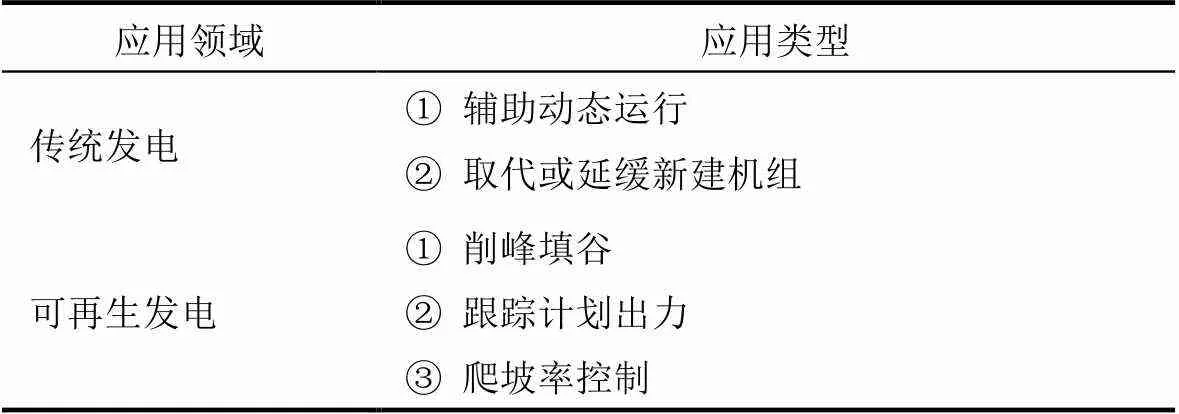
表1 压缩空气储能系统应用领域和类型
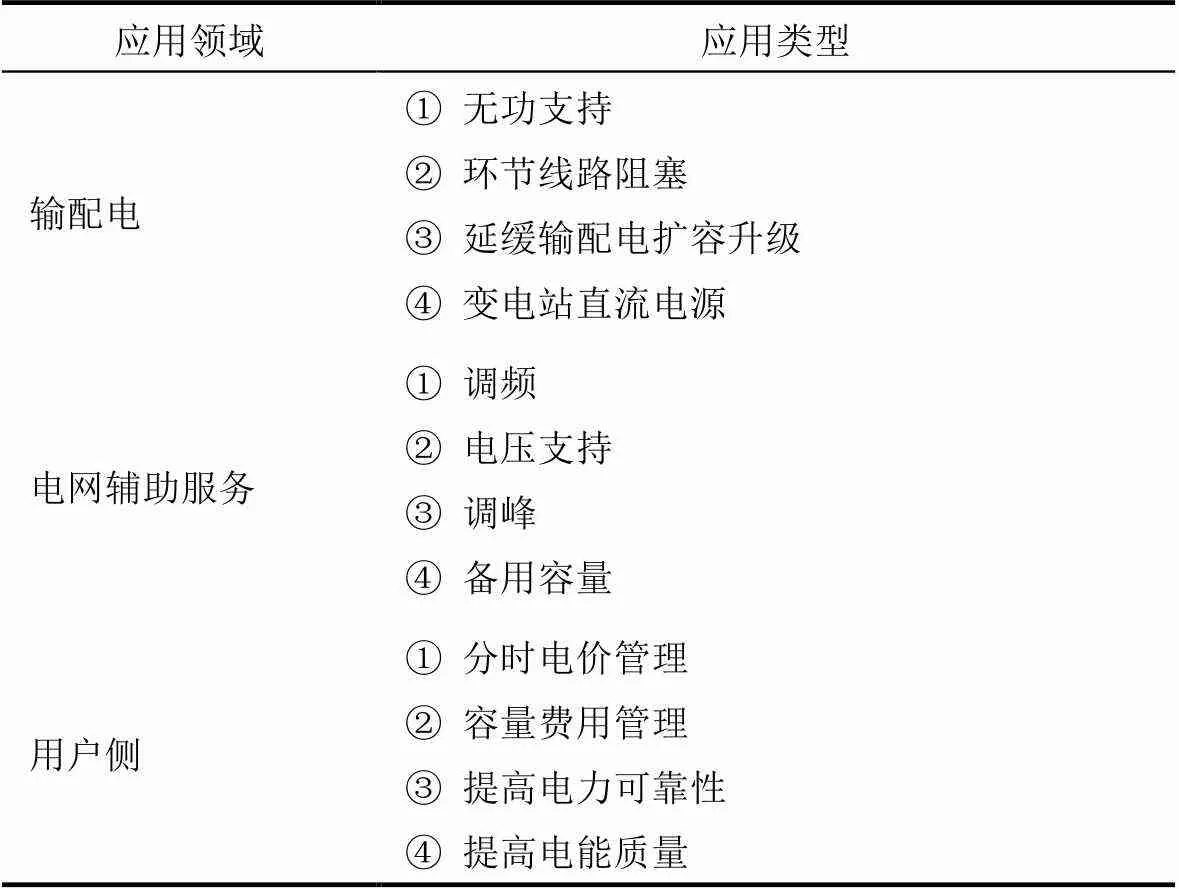
续表

表2 CAES发展和应用现状
2 储气装置分类及技术研究
储气装置作为压缩空气储能系统的重要组成部分,选择合适的储气装置关系到整个系统的效率、经济性、运行可靠性、稳定性等各方面的因素。常见的压缩空气储能系统的储气装置分类如表3所示[13-17]。
目前工程应用的储气装置一般分为地下储气装置和地上储气装置,具体类型如表4所示[18-24]。

表3 储气装置分类

表4 地下储气装置和地上储气装置具体类型
对于AA-CAES系统的储气装置的研究,有学者用模拟的方法针对具体地形进行了研究,也有学者用理论分析的方法针对人造存储容器开展了相关的工作。表5所示为近年来国内外相关专家对于CAES储气装置的研究和分析现状综述。
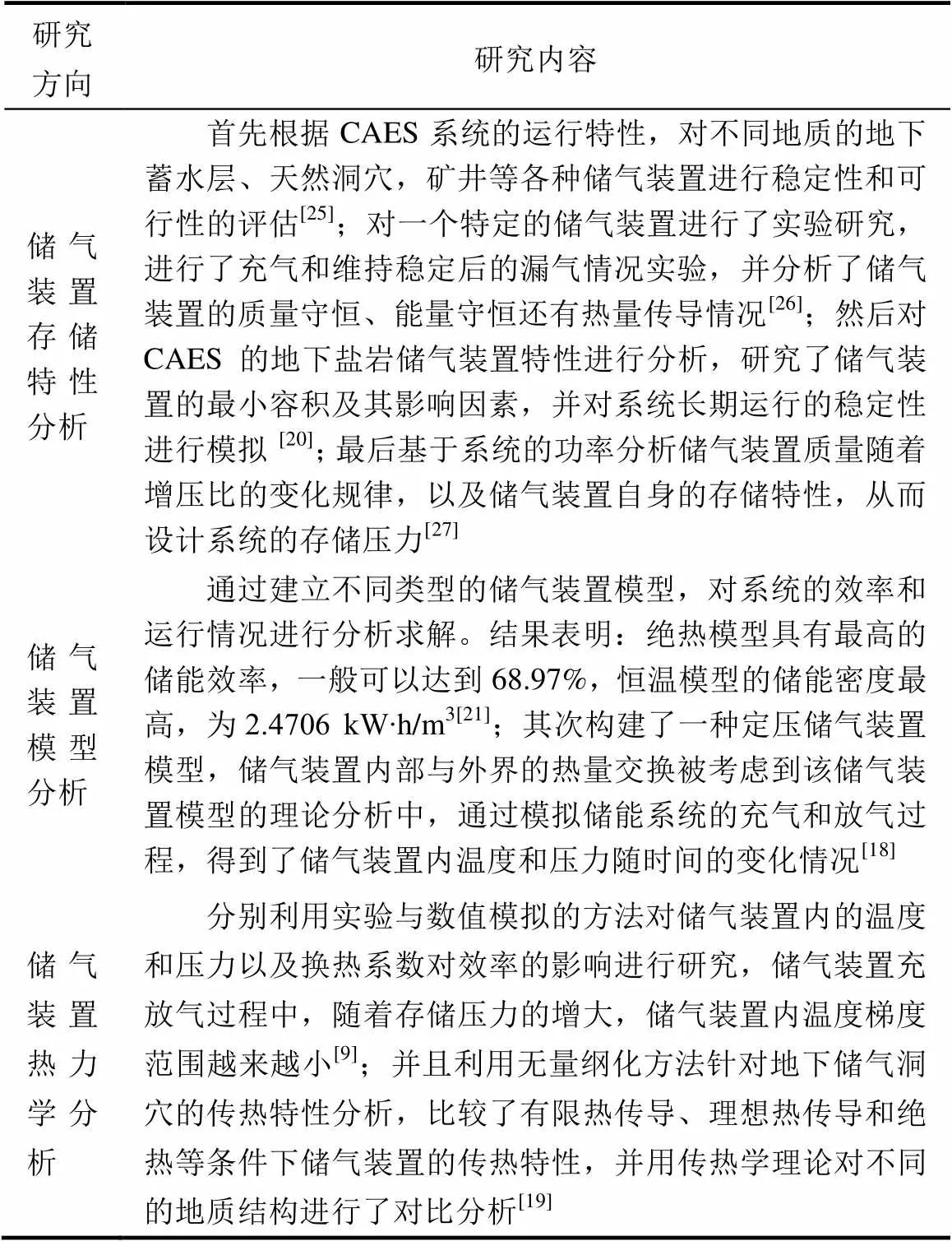
表5 储气装置研究方向与技术现状
3 CAES储气装置评价指标
为了简化计算,不对能量转移过程的复杂过程进行深入研究,压缩空气被认为是理想的气体,通过管道和阀门的压力损失被忽略。假设为恒温过程,由于存储空气和环境之间的热传递,在能量释放过程中空气存储装置中的温度变化被忽略。减压阀后的空气应该被周围环境加热[25-28]。
假设空气为理想气体,理想气体状态方程:

式中,为空气压力,Pa;为空气体积,m3;为空气质量,kg;为温度,K。
3.1 储气质量
根据理想气体状态方程,储气装置内储气的总质量为:
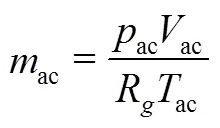
式中,ac为储气装置压力,Pa;ac为储气装置体积,m3;为储气装置温度,K。
3.2 储气体积
储气装置所能存储气体体积应当与存储能量和压缩机升压比有关,具体关系为:
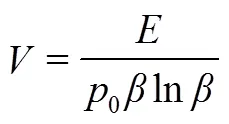
式中,为气体存储㶲,W;0是大气压力,Pa;为压缩机的升压比。
储气装置中高压空气储存的㶲主要是压力㶲。有效能在大气温度下为:
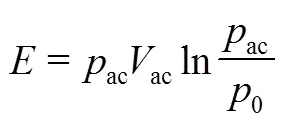
3.3 储气装置质量
储气装置质量应当与所选材料和所存储气体能量有关。具体关系为:
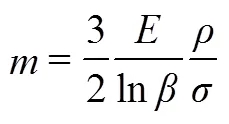
式中,为储气装置材料密度,kg/m3;为储气装置材料的最大应力,Pa。
3.4 储气装置体积
根据理想气体状态方程,释能阶段储气装置状态参数关系为:


式中,Vc表示储气装置体积,单位m3;s0表示释能初始时刻气体压力;s1表示释能终了时刻气体压力;s0表示释能初始时刻气体温度,K;s1表示释能终了时刻气体温度,K。
由此可得储气装置体积为:

3.5 储能密度
储能密度是衡量储气装置储能能力的重要指标,储能密度为:
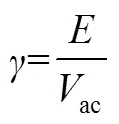
4 CAES储气装置热力学分析
空气经过多级压缩和多级换热的过程以后,进入储气装置,如果把储气装置看作控制容积,根据质量守恒方程得到:
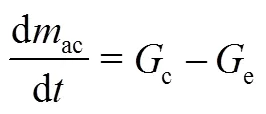
式中,ac是储气装置内气体总质量,kg;c是进入储气装置的质量流量,kg/h;e是流出储气装置的质量流量,kg/h。
根据热力学第一定律得:

式中,是空气的内能,J;ac是环境与储气装置外壁面的传热系数,ac是储气装置外表面面积,m3;0是环境温度,K;c是储气装置进口空气的比焓,J;e是储气装置出口空气的比焓,J。
为了简化上述方程,引入理想气体状态方程:

我们可以得到简化后储气装置内温度和压力随时间的变化,决定了空气在储气装置内状态:
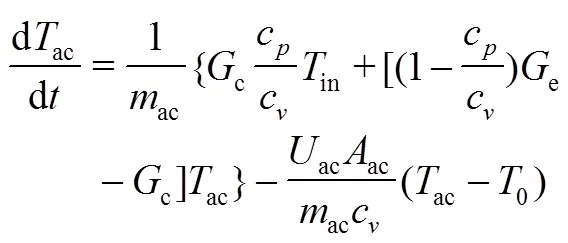
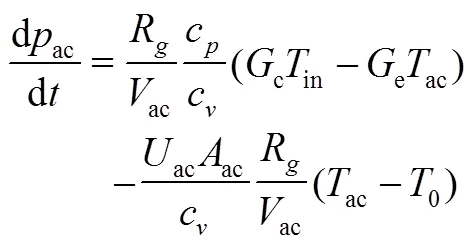
式中,c是空气的定压热容,kJ/(kg·K);c是空气定容比热,kJ/(kg·K);ac是储气装置内空气的温度,K;ac是储气装置内空气的压力,Pa;in是进入储气装置空气的温度,K;ac是储气装置的体积,m3;R=287 kJ/(kg·K),是气体常数。
一般地,储气装置外表面与环境的传热系数ac不是定值,而是与储气装置特性有关。

式中,0是环境压力,0是传热系数,当ac=0时质量流量为0;表示压力和对传热系数的影响,表示质量流量对传热系数的影响。
5 结论与展望
5.1 结 论
(1)对于地面储气装置和人造储气装置的研究还属于理论阶段,缺少实质性的分析和研究,尤其对于各种不同工况下的储气装置的研究;
(2)储气装置的研究主要集中在利用理论分析与数值模拟方法对系统的热力学参数敏感性分析,但现有的研究工作还不够完善,仿真模拟和实验研究还很欠缺;
(3)对储气装置的热力学参数随系统循环运行过程的动态模型的研究还很少,所以对先进绝热压缩空气储能系统的储气装置进行进一步的研究很有必要。
(4)储气装置相关的设计以及其充放气过程尚需完善,现有的CAES电站一般均采用恒容储气装置,通过减压阀进行放气操作控制排气压力,节流作用的影响导致其能量损失较大;
(5)系统在稳定循环过程中,目前对于储气装置内工质的温度、压比及其它因素随时间变化的相关研究较少,缺少相关的技术支持;
(6)目前的大多数的研究仅从CAES及储气装置的热力性能、系统设计等相关方面进行分析,缺少系统和储气装置的经济性分析,对于后期的大规模应用来说,经济性至关重要。
压缩空气储能技术在我国的发展尚处于理论研究阶段,因此对于先进压缩空气储能系统的设计进行研究和分析需要加大力度。
5.2 展 望
目前,国内外对于压缩空气储能系统及其储气装置更多的还处于实验研究阶段。德国Huntorf电站和美国McIntosh电站的运行证明,这项技术的概念设计和合理规模是可以接受的。但是这两个电站所采用的储气装置都是利用地下储气装置。德国Huntorf电站的储气装置为两个地下岩盐层的空洞,洞室容积共约31,0000 m3,储气装置最小运行压力为20 bar,通常情况下,储气装置运行压力在42~72 bar。美国McIntosh电站储气装置为53,8000 m3的地下盐洞,储气装置通常工作压力为45~74 bar。对于地面储气装置的应用和发展研究目前尚处于理论研究阶段。在此基础上,未来在以下方面进行深入探讨。
(1)储气装置作为整个压缩空气储能系统占地面积和体积最大的设备之一,如何合理的设计和布置是需要我们重点研究的内容之一。
(2)地下储气装置和地面储气装置存在很多的异同点,因此如何通过借鉴现有的已经投入商业运行的地下储气装置来研究地面储气装置和人造储气装置至关重要。目前还缺少相关的实质性的分析和研究,尤其对于各种不同工况下的储气装置的研究。
(3)目前对于地上和人造储气装置的研究主要集中在利用理论分析与数值模拟方法对系统的热力学进行参数进行敏感性分析,并且现有的研究工作还不够完善,尤其是实际的仿真模拟和实验研究还很欠缺,实验用的小型储气装置如何转化成实际可以投入商业运行的储气装置还需要很多的工作。
(4)目前的研究仅从CAES及储气室的热力性能角度进行分析,未考虑系统的经济性指标,一旦投入商业运行,经济性将是人们第一位需要考虑的问题。因此如何在实际情况和实际建设的经济性分析和系统的评价体系方面进行完善,尤其实际设备选型计算各系统的热经济性和投入产出经济性,是重要的研究分析之一。
储气装置作为整个压缩空气储能系统的重要部件具有重要研究意义。如何更好的分析系统的性能,通过基于热力学理论分析建立系统仿真模型,对系统进行仿真分析,并对系统进行实验研究,把仿真结果与实验结果进行对比,得到能够真正投入商业运行的地上储气装置是未来研究的重要方向。
[1] 赵振宇, 范磊磊. 可再生能源法规、政策分析及其对发电结构的影响[J]. 可再生能源, 2010, 28(4): 5-9.
ZHAO Zhenyu, FAN Leilei. Renewable energy regulation, policy analysis and its impact on power generation structure[J]. Renewable Energy, 2010, 28(4): 5-9.
[2] 樊柳言, 曲德林, 汪海波, 等. 福岛核危机后日本新能源格局的转变及其影响与启示[J]. 中外能源, 2011, 16(8): 29-34.
FAN Liuyan, QU Delin, WANG Haibo, et al. The transformation of Japan's new energy pattern after the fukushima nuclear crisis and its implications and implications[J]. China and Foreign Energy, 2011, 16(8): 29-34.
[3] 关晓慧, 吕跃刚. 间歇性可再生能源发电中的储能技术研究[J]. 能源与节能, 2011(2): 56-60.
GUAN Xiaohui, LU Yuogang. Research on energy storage technology in intermittent renewable energy generation [J]. Energy and Energy Conservation, 2011(2): 56-60.
[4] 陈海生, 刘金超, 郭欢, 等. 压缩空气储能技术原理[J]. 储能科学与技术, 2013, 2(2): 146-151.
CHEN Haisheng, LIU Jinchao, GUO Huan, et al. Principle of compressed air energy storage technology[J]. Energy Storage Science and Technology, 2013, 2(2): 146-151.
[5] RIBEIRO P F, JOHNSON B K, CROW M L, et al. Energy storage systems for advanced power applications[J]. Proceedings of the IEEE, 2001, 89(12): 1744-1756.
[6] ISLAM M R, MEKHILEF S, SAIDUR R. Progress and recent trends of wind energy technology[J]. Renewable & Sustainable Energy Reviews, 2013, 21(5): 456-468.
[7] LUND H, SALGI G. The role of compressed air energy storage (CAES) in future sustainable energy systems[J]. Energy Conversion & Management, 2009, 50(5): 1172-1179.
[8] 张文亮, 丘明, 来小康. 储能技术在电力系统中的应用[J]. 电网技术, 2008, 32(7): 1-9.
ZHANG Wenliang, QIU Ming, LAI Xiaokang. The application of energy storage technology in power system [J]. Power grid Technology, 2008, 32(7): 1-9.
[9] 李雪梅. 先进绝热压缩空气储能系统部件特性对系统性能影响的研究[D]. 北京: 中国科学院, 2015.
LI Xuemei. Research on the effects of advanced adiabatic air energy storage system components on system performance[D]. Beijing: China Academy of Sciences Graduate School (Engineering Institute of Thermal Physics), 2015.
[10] 刘金超, 徐玉杰, 陈宗衍, 等. 压缩空气储能储气装置发展现状与储能特性分析[J]. 科学技术与工程, 2014, 14(35): 148-156.
LIU Jinchao, XU Yujie, CHEN Zongyan, etc. The development status and energy storage characteristics of compressed air storage devices[J]. Science and Technology and Engineering, 2014, 14(35): 148-156.
[11] KORPAAS M, HOLEN A T, HILDRUM R. Operation and sizing of energy storage for wind power plants in a market system[J]. International Journal of Electrical Power & Energy Systems, 2003, 25(8): 599-606.
[12] HUBERT S, MATTERA F, MALBRANCHE P. Investire network - investigation of storage technologies for intermittent renewable energies in Europe[J]. Journal of Power Sources, 2003, 116(1): 287.e40- 287.e43.
[13] HADJIPASCHALIS I, POULLIKKAS A, EFTHIMIOU V. Overview of current and future energy storage technologies for electric power applications[J]. Renewable & Sustainable Energy Reviews, 2009, 13(6/7): 1513-1522.
[14] CHATZIVASILEIADI A, AMPATZI E, KNIGHT I. Characteristics of electrical energy storage technologies and their applications in buildings[J]. Renewable & Sustainable Energy Reviews, 2013, 25(5): 814-830.
[15] 刘文毅, 杨勇平. 用于分布能量系统的微型压缩空气蓄能(MCAES)系统性能计算与优化[J]. 工程热物理学报, 2006, 27(6): 911-913.
LIU Wenyi, YANG Yongping. Calculation and optimization of microcompressed air energy storage (MCAES) system for distributed energy systems [J]. Journal of Engineering Thermal Physics, 2006, 27(6): 911-913.
[16] WANG S, CHEN G, FANG M, et al. A new compressed air energy storage refrigeration system[J]. Energy Conversion & Management, 2006, 47(18): 3408-3416.
[17] BEUKES J, JACOBS T, DERBY J, et al. Suitability of compressed air energy storage technology for electricity utility standby power applications[C]. 2008 IEEE International Telecommunications Energy Conference, 2008: 1-4.
[18] NIELSEN L, LEITHNER R. Dynamic simulation of an innovative compressed air energy storage plant- detailed modeling of the storage cavern[J]. WSEAS Transactions on Power Systems, 2009, 4(8): 253-263.
[19] KUSHNIR R, DAYAN A, ULLMANN A. Temperature and pressure variations within compressed air energy storage caverns[J]. International Journal of Heat & Mass Transfer, 2012, 55(21/22): 5616-5630.
[20] 杨花. 压气蓄能过程中地下盐岩储气库稳定性研究[D]. 武汉: 中国科学院武汉岩土力学研究所, 2009.
YANG Hua. Stability study of underground salt reservoirs in the process of pressurized gas storage[D]. Wuhan: Graduate School of Chinese Academy of Sciences (Wuhan Institute of Geotechnical Mechanics), 2009.
[21] 韩中合, 刘士名, 周权, 等. 恒壁温储气模型下先进绝热压缩空气储能系统性能分析[J]. 中国电机工程学报, 2016, 36(12): 3373-3380.
HAN Zhonghe, LIU Shiquan, ZHOU Quan, et al. Analysis of the performance of advanced adiabatic compressive air energy storage system under the constant wall temperature gas storage model[J]. Journal of China Electrical Engineering, 2016, 36(12): 3373-3380.
[22] ULLMANN A, KUSHNIR R, DAYAN A. Thermodynamic models for the temperature and pressure variations within adiabatic caverns of compressed air energy storage plants[J]. Journal of Energy Resources Technology, 2012, 134(2): 1-10.
[23] KIM H M, RUTQVIST J, RYU D W, et al. Exploring the concept of compressed air energy storage (CAES) in lined rock caverns at shallow depth: A modeling study of air tightness and energy balance[J]. Applied Energy, 2012, 92(2): 653-667.
[24] PROCZKA J, MURALIDHARAN K, VILLELA D, et al. Guidelines for the pressure and efficient sizing of pressure vessels for compressed air energy storage[J]. Energy Conversion & Management, 2013, 65: 597-605.
[25] ALLEN R D, DOHERTY T J, KAMBERG L D. Summary of selected compressed air energy storage studies[R]. Richland, WA: Pacific Northwest Laboratory, 1985.
[26] NAKAYAMA A, YAMACHI H. Thermodynamic analysis of efficiency and safety of underground air energy storage system[J]. Report of Research Center for Urban Safety & Security Kobe University, 1999, 3: 247-254.
[27] GRAZZINI G, MILAZZO A. Thermodynamic analysis of CAES/TES systems for renewable energy plants[J]. Renewable Energy, 2008, 33(9): 1998-2006.
[28] 刘澧源, 蒋中明, 王江营, 等. 压气储能电站地下储气库之压缩空气热力学过程分析[J]. 储能科学与技术, 2018, 7(2): 232-239.
LIU Liyuan, JIANG Zhongming, WANG Jiangying, et al. Analysis of the thermodynamics process of compressed air in the underground gas storage reservoir of pressurized gas storage plants [J]. Energy Storage Science and Technology, 2018, 7(2): 232-239.
The development status and energy storage characteristic of gas storage device of compressed air energy storage system
LUO Ning, HE Qing, LIU Wenyi
(School of Energy Power and Mechanical Engineering, North China Electric Power University, Beijing 102206, China)
Compressed air energy storage system, as one of the most promising energy storage technologies, is developing rapidly. Gas storage room is one of the main components of compressed air energy storage system. Firstly, the development, application and research status of compressed air energy storage system are reviewed, and the characteristics of commercial energy storage power station and demonstration power station are put forward. Secondly, the development and application of the gas storage device are analyzed in detail, including the classification of gas storage devices, the technical characteristics and application status of different types of gas storage devices, and the energy storage characteristics of the gas storage devices are analyzed in detail. Finally, the technical problems and related parameters and evaluation indexes of the gas storage device are analyzed and arranged. The development direction and research emphasis of compressed air energy storage and its storage device were put forward.
compressed air energy storage; gas storage devices; energy storage property; assessment index
10.12028/j.issn.2095-4239.2017.0180
TK 02
A
2095-4239(2018)03-0489-06
2017-12-23;
2018-01-18。
国家重点研发计划项目(2017YFB0903601)。
罗宁(1994—),男,硕士研究生,研究方向为电站设备故障诊断与状态监测、压缩空气储能技术,E-mail:15210793939@163.com。

